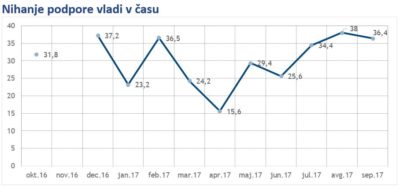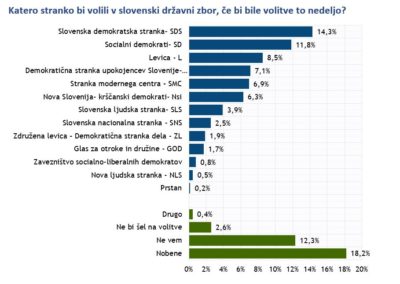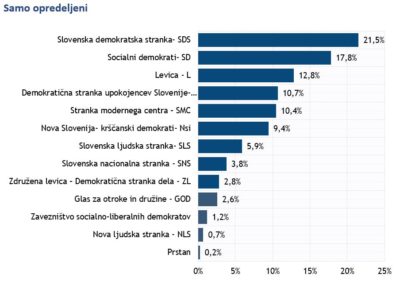If the Slovenian parliamentary election were held this year, Janša’s Slovenian Democratic Party (SDS) would win convincingly, being the only party that continuously maintains a high level of support. It is followed by Židan’s Social Democrats (SD) and The Left, while Cerar’s ruling Modern Centre Party (SMC) dropped to fifth place. An overwhelming majority is dissatisfied with the government coalition of SMC, DeSUS, and SD and their work.
“The government seems to have the highest support in the summer months, when it is least active, and generally only about a third of voters still support it,” estimates Dr Matej Lahovnik and adds: “Many voters are still uncommitted, and as usual it will be most important what will happen in the spring, in the last months before the election, and who will able to convince and activate the still uncommitted and passive voters to go vote.”
The average age of the respondents is 50.4 years, and they come from all over Slovenia – most of them, about a fourth, come from the Central Slovenia region. The majority of the respondents, 39.5%, are part of the oldest age group (55 years or more), 36% are part of the middle age group (35–54 years), and 24.5% are part of the youngest age group (18–34 years). A majority of the respondents have a secondary education (32.6%), followed by those with a complete or incomplete primary education (23.6%). 22.2% of the respondents have a vocational education, and 21.6% have a higher education.
The survey was carried out in the period from 11 September to 13 September 2017 with a sample of 700 respondents (50% of which were women), and it was conducted by the company for market research and opinion polling Parsifal SC. It was a telephone survey, and the sampling frame encompassed the telephone directory (80% the mobile network and 20% the fixed network). The survey measured the support for the current Slovenian Government and the balance of power between the political parties.

Majority is disappointed with work of Cerar’s government
For the majority of Slovenians (58.9%), the cabinet of Miro Cerar did not justify expectations, and they are disappointed with the current government; 36.4% of voters support the government, while 4.7% of voters remain undecided.
The middle age group (35–54 years) is the most dissatisfied with the work of the SMC–DeSUS–SD coalition with 65.1%, while the oldest age group (55 years or more) is the most supportive of the government with 42.5%. As far as education is concerned, dissatisfaction with the government is highest among people with a primary or lower education (61.2%), while the government has the most support among people with a higher education (40%).

Support for SMC, DeSUS, and SD coalition dropped
The support for Cerar’s government has decreased by 1.6 percentage points in the last month (38% in August; 36.4% in September), and at the same time well over half of Slovenian citizens (58.9%) remain dissatisfied with the work of the government. The graph of fluctuations in the support for the Slovenian Government shows a relatively low support, and as a rule, it ranges between one fourth and one third.


SDS remains on top, SMC only in fifth place
If an early election were held this year, most Slovenian citizens would vote for SDS (14.3%), followed by SD (11.8%) and L (8.5%), while 4th place has been taken by DeSUS (7.1%). Cerar’s ruling SMC has dropped to 5th place and is supported by only 6.9% of voters. A large number of respondents are uncommitted, and most of them would not vote for any of the listed parties (18.2%); 12.3% of respondents are undecided, while 2.6% of them would definitely not go vote. 0.4% of the respondents would vote for a potential new party or a party that is not listed in the survey.
As far as education is concerned, SDS enjoys its greatest support among people with a vocational education (20.3%), the second-placed SD is supported most strongly by people with a secondary education (17.7%), while the third-placed party, The Left, enjoys its greatest support among people with a higher education (14.8%). The fourth placed DeSUS has the greatest support among people with a primary or lower education (18.2%), while the ruling SMC, which is in 5th place, is supported most by people with a vocational education (11.8%).

1. SDS, 2. SD, 3. L
Among committed voters, the balance of power is as follows: the Slovenian Democratic Party – SDS is in first place (21.5%), the Social Democrats – SD are second (17.8%), and third place has been taken by Mesec’s Left (12.8%). Other existing parliamentary parties that would again join the “house of democracy” are Erjavec’s DeSUS (10.7%), Cerar’s Modern Centre Party – SMC (10.4%), which dropped to 5th place, and New Slovenia – Christian Democrats – NSi (9.4%). Zidanšek’s Slovenian People’s Party – SLS (5.9%) would return to the house of democracy, while Jelinčič’s Slovenian National Party – SNS (3.8%) would miss out on a place in the Slovenian parliament by a hair’s breadth.
The United Left – Democratic Labour Party (2.8%), Primč’s Voice for Children and Families – GOD (2.6%), the Alliance of Social Liberal Democrats (1.2%), Kangler’s New People’s Party of Slovenia – NLS (0.7%), and the liberal party Prstan (0.2%) would also end up outside the National Assembly of Slovenia.
Jure Ferjan

